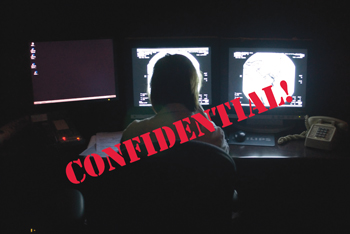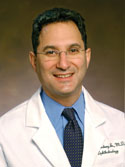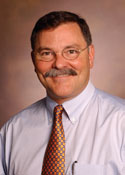
The Vanderbilt Eye Institute’s new home will make its debut in the South Garage Office Building next spring.
New vision in store for Vanderbilt Eye Institute

Paul Sternberg, M.D.

John Penn, Ph.D.
by Jessica Pasley
The Vanderbilt Eye Institute's future is looking increasingly bright.
“We are committed to making the Vanderbilt Eye Institute one of the great eye programs in the country, a place that delivers great patient care and has a dynamic research component as well,” said Harry Jacobson, M.D., vice chancellor for Health Affairs.
Next March, the program will move into its new home in the South Garage Office Building, a home that will be larger and better suited to deal with a burgeoning volume of patients than its present Medical Center East location.
The $11 million renovation project is effectively doubling space for the program to approximately 50,000 square feet.
“The leadership has been steadfast in its commitment,” said Paul Sternberg, M.D., chair of Ophthalmology and Visual Sciences and director of the Vanderbilt Eye Institute (VEI).
“For us, the most exciting aspect is simply having adequate space to handle the dramatic increase in patient volume that we are experiencing.
“The ultimate goal is to create a comprehensive, state-of-the-art, world-recognized eye program,” Sternberg said.
The new, technologically advanced facility will have 53 exam rooms, a sizeable increase over the 33 exam rooms currently available. When complete, the facility will house the Tennessee Lion's Eye Center for Children, a refractive laser suite, diagnostics area, an optical retail shop, departmental offices and designated exam and waiting room areas for all sub-specialty care.
The expansion of space for the program reflects a substantial dedication to growing ophthalmology, vision research and eye care services at Vanderbilt.
“The opening of this new home for the Eye Institute is both a symbol of commitment and a catalyst to the growth and change that are the hallmarks of a great program,” Jacobson said.
Since construction began a year ago, the project has seen several changes including studying whether an operating suite would be feasible with the adjacent parking structure. It was decided that the vibration from moving vehicles was too risky. Minor procedures, laser surgery and refractory services will be available in the new location.
“We will have dedicated space for education and will be able to leverage a lot of the electronic technology to be able to provide high-tech imaging for diagnostic testing and efficient, comprehensive patient care,” said Sternberg.
“Our service will involve the same doctors and the same excellent care, it will just be in a more comfortable setting.”
Patients are being alerted to the impending move.
“Many of our patients are elderly so 'way finding' is difficult, but there is a tremendous advantage for them, and the community as a whole, because of the ease of access with this building,” Sternberg said.
“We are deeply committed to patient welfare, groundbreaking discoveries and quality training. We want to prioritize teaching. We have had a wonderful response nationwide to our increased focus on education, with a 20 percent increase in applications into our residency and fellowship programs.”
Along with the expansion and move of patient-related services to the new facility, the research component of VEI will also see a major change with a move to MRB IV, atop Langford Auditorium.
“Our move will allow us to implement the next stage of our research strategic plan,” said John Penn, Ph.D., vice chair of Ophthalmology and director of research for VEI. “In addition to housing the existing vision scientists, our new space will contain fully equipped benches to accommodate an additional group of investigators to be recruited over the next two years.
“These new faculty recruits will provide us with solid depth in all three of our areas of research emphasis – vascular biology, oxidative stress and neuroprotection – and may allow us to expand the plan to include other areas of emphasis. I believe we are poised to truly distinguish ourselves among the nation's eye institutes.”
A $5 million capital campaign to help fund construction is under way, and more than $1.7 million in committed gifts and pledges has been received.













